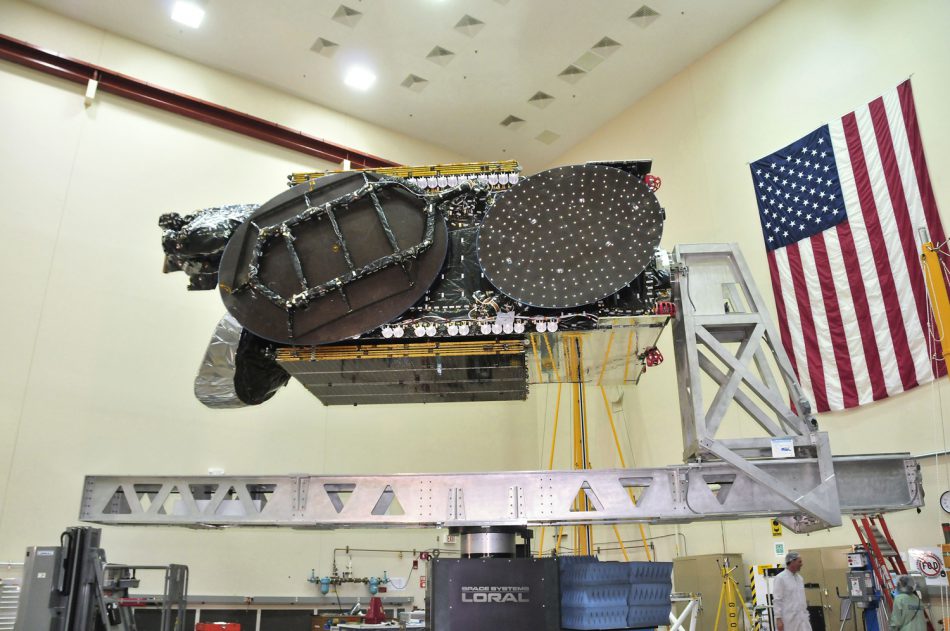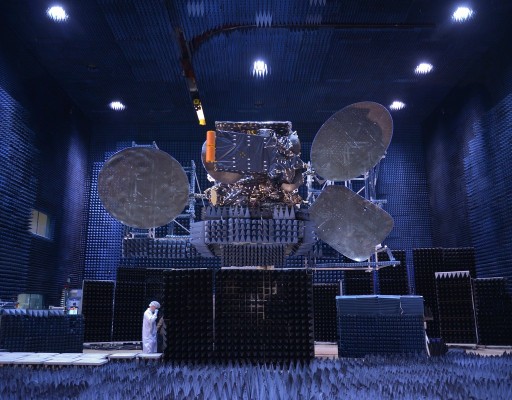
Back to selection

Supplier
Intelsat
Intelsat, Inc.
7900 Tysons One Place
McLean, VA 22102
USA
Intelsat S.A. is world’s largest communications satellite services provider. Originally formed as International Telecommunications Satellite Organization (INTELSAT), it was, from 1964 to 2001, an intergovernmental consortium owning and managing a constellation of communications satellites providing international broadcast services.
Intelsat S.A. currently operates a fleet of more than 55 communications satellites, which is one of the world’s largest fleet of commercial satellites. All of the Spacecraft operations are controlled through ground stations in Hagerstown, Maryland (USA), Riverside, California (USA), and Intelsat’s biggest Teleport Fuchsstadt in Germany. The company is serving approximately 1,500 customers worldwide and employs a staff of approximately 1,100 people.
Company History
The Inter-Governmental Organization (IGO) began on August 20th 1964, with 11 participating countries. On April 6th 1965, Intelsat’s first satellite, the Intelsat I (nicknamed Early Bird), was placed in geostationary orbit above the Atlantic Ocean by a Delta D rocket.
Back in 1973, the name was changed and there were 80 signatories. Intelsat provides service to over 600 Earth stations in more than 149 countries, territories and dependencies. By 2001, Intelsat had over 100 members. It was also this year that Intelsat privatized and changed its name to Intelsat.
Since its inception, Intelsat has used several versions (blocks) of its dedicated Intelsat satellites. Intelsat completes each block of spacecraft independently, leading to a variety of contractors over the years. Intelsat’s largest spacecraft supplier is Space Systems/Loral (SS/L), having built 31 spacecraft (as of 2003), or nearly half of the fleet.



The network in its early years was not as robust as it is now. A failure of the Atlantic satellite in the spring of 1969 threatened to stop the Apollo 11 mission; a replacement satellite went into a bad orbit and could not be recovered in time; NASA had to resort to using undersea cable telephone circuits to bring Apollo’s communications to NASA during the mission. Fortunately, during the Apollo 11 moonwalk, the moon was over the Pacific Ocean, and so other antennas were used, as well as INTELSAT III, which was in geostationary orbit over the Pacific.
By the 1990’s, building and launching satellites was no longer exclusively a government domain and as country-specific telecommunications systems were privatized, several private satellite operators arose to meet the growing demand. In the U.S., satellite operators such as Panamsat, Orion Communications, Columbia Communications, Iridium, Globalstar, TRW and others formed under the umbrella of the Alliance for Competitive International Satellite Services (ACISS) to press for an end to the IGO’s and the monopoly position of COMSAT the US signatory to Intelsat and Inmarsat. In March 2001, the US Congress passed the Open Market Reorganization for the Betterment of International Telecommunications (ORBIT) Act to privatize COMSAT and reform the role of the international organizations. In April 1998, to address US government concerns about market power, Intelsat’s senior management spun off five of its older satellites (IntelSat 513 (183° E), IntelSat 703 (57° E), IntelSat 803 (338.5° E), IntelSat 806 (319.5 E), IntelSat K (338.5° E) to a private Dutch entity, New Skies Satellites, which became a direct competitor to Intelsat. To avert the US government’s interference with Intelsat, Intelsat’s senior management unsuccessfully considered relocating the IGO to another country.
On July 18th in 2001, 37 years after formation, Intelsat became a private company. Prior to Intelsat’s privatization in 2001, ownership and investment in Intelsat (measured in shares) was distributed among Intelsat members according to their use of services. Investment shares determined each member’s percentage of the total contribution needed to finance capital expenditures. The organization’s primary source of revenue was satellite usage fees that, after deduction of operating costs, were redistributed to Intelsat members in proportion to their shares as repayment of capital and compensation for use of capital. Satellite services were available to any organization (both Intelsat members and non-members), and all users paid the same rates.
As of today, the number of Intelsat satellites, as well as ocean-spanning fiber-optic lines, allows rapid rerouting of traffic when one satellite fails. Modern satellites are more robust, lasting longer with much larger capacity.
In 2004 Intelsat Americas-7 (aka Telstar-7 and now known as Galaxy-27) experienced a several-day power failure on November 29th. The satellite returned to service with reduced capacity.
In January 2005 Intelsat was sold for 3.1bn USD to four private equity firms; Madison Dearborn Partners, Apax Partners, Permira and Apollo Global Management.
In July 2006 the company acquired satellite operator PanAmSat for 6.4 billion USD and became the world’s largest provider of fixed satellite services. Using a combined fleet of 53 satellites, the company would serve customers in more than 220 countries and territories.
In June 2007 UK-based private equity firm BC Partners announced the acquisition of 76% of Intelsat for about 5 billion USD. The deal is the largest in BC Partners’ history and its first acquisition of a company with U.S. headquarters.
In April 2013 the renamed Intelsat S.A. undertook an initial public offering on the New York Stock Exchange, raising a net 550 million USD, of which 492 million USD was paid immediately to reduce outstanding company debts of 15.9 billion USD. In May the company announced it would be purchasing four new high-performance EpicNG 702 MP satellites from satellite manufacturer Boeing Commercial Satellite Systems (BCSS).
In 2018 the four leading satellite operators, Intelsat, SES, Eutelsat and Telesat established the C-Band Alliance (CBA) in a move that could accelerate making mid-band spectrum available for 5G. The proposal establishes a commercial and technical framework that would enable terrestrial mobile operators to access spectrum in a portion of the 3,700 to 4,200 Megahertz frequency band in the USA, speeding the deployment of next-generation 5G services.
In 2019 Intelsat S.A. joined GSMA, the organization representing mobile operators worldwide, to further strengthen the integration of satellite and terrestrial technologies and advance 5G deployments.
On May 13th 2020 Intelsat S.A. filed for Chapter 11 bankruptcy protection in order to restructure their 15 billion USD debt and join an FCC spectrum clearing program. Intelsat planned to join the FCC’s accelerated clearing of the C-band spectrum to make way for faster 5G wireless satellite communications. The company, like many other space industry firms, also experienced some economic fallout from the COVID19 pandemic. Intelsat was the third satellite company in as many months to file for bankruptcy. Satellite constellation startup OneWeb filed for Chapter 11 bankruptcy in March, followed by Speedcast in April 2020.
In February 2022 the company emerged from a long Chapter 11 process and became a private company. The reorganization reduced the company’s debt by more than half, from approximately 16 billion USD to 7 billion USD.Intelsat also obtained 6.7 billion USD in new financing consisting of a revolving credit facility, term loan and secured notes.
In August 2022 Intelsat lost control over their Galaxy 15 (G-15) satellite and Intelsat engineers have shut down the satellite’s payload. G-15 was no longer transmitting signals back to Earth and operators were re-programming the services as the spacecraft drifted out of its orbital position. Intelsat coordinated “fly-by” procedures to avoid physical collision with another spacecraft. G-15 customers were moved to Galaxy 23 for the time being, until G-15’s replacement, Galaxy 33, launches in October 2022.
On March 19th, 2024 Intelsat announced the expansion of its partnership with satellite operator Eutelsat Group for the company’s OneWeb Low-Earth Orbit (LEO) constellation. Intelsat committed to 250 million USD for LEO services over the following six years, with an option for an additional 250 million USD. The deal would result in a significant development for multi-orbit satellite connectivity solutions, and will increase and further integrate LEO capabilities into Intelsat’s solutions.
On April 30th, 2024, rival satellite operator SES acquired Intelsat for 3.1 billion USD, pending regulatory approvals. This merger unites two of the largest operators of commercial GEO communications satellites, a sector that once dominated the space industry but now faces challenges due to declining demand from traditional television services and the rise of LEO constellations like SpaceX’s Starlink. Together, the companies boast a combined fleet of over 100 GEO satellites, along with SES’s medium Earth orbit O3b constellation.
In October 2024 the company declared the Intelsat-33e (IS-33e) satellite a total loss after a recent anomaly affecting customers is Europe, Africa and parts of Asia-Pacific. Intelsat first reported a service outage on the satellite on October 2019. Data and observations were analyzed with manufacturer Boeing, to find the cause of the failure. Intelsat-33e is part of the Intelsat Epic high throughput satellite (HTS) series, which consists of IS-29e, IS-33e, and IS-32e all based on the Boeing 702MP-platform. The IS-33e anomaly is the second in-orbit failure for the Epic fleet, IS-29 failed in 2019. after the propulsion system sprung a leak and the satellite could not be recovered.
All trademarks, logos and images mentioned and showed on this page are property of their respective owners.
Resources
www.intelsat.com
www.WTA.com
www.satbeams.com
www.tbs-satellite.com
www.spacedaily.com
www.space.skyrocket.de
www.wikipedia.org
www.sky-brokers.com
www.astronautix.com
www.daviddarling.info
www.spaceref.com
www.spacewar.com
www.claudelafleur.qc.ca
www.spacenews.com edition June 29th 2006
www.businesswire.com edition June 19th 2007
www.reuters.com edition June 19th 2007
www.macrostate.com
www.boeing.com
www.spacevids.tv
www.viasatellite.com article: Intelsat and Azercosmos Play Up Strengths in New Partnership by Juliet Van Wagenen, 23 March 2015.
www.satellitetoday.com edition October 1st 2018
www.gsma.com
www.space.com edition May 14th 2020
www.fortune.com edition May 14th 2020
www.investors.intelsat.com
www.satellitetoday.com edition February 24th, 2022
www.satellitetoday.com edition September 1st, 2022
www.satellitetoday.com edition March 19th, 2024
www.spacenews.com edition April 30th, 2024
www.satellitetoday.com edition October 21st, 2024

Supplier
Intelsat
Intelsat, Inc.
7900 Tysons One Place
McLean, VA 22102
USA
Satellites manufactured by Intelsat
| Spacecraft | Country | |||
| Intelsat-903 (IS-903)GEO | - | Intelsat |  | Broadcasting |
Satellite fleet by Intelsat
| Spacecraft | Country | |||
| Amazonas Nexus (IS-46)GEO | 61° West | Hispasat |  | Communication |
| Azerspace-2/Intelsat-38 (IS-38)GEO | 45° East | Azercosmos |  | Communication |
| EchoStar IX (Telstar-13, Intelsat Americas 13, Galaxy-23)GEO | 121° West | EchoStar |  | Communication |
| Galaxy-10R (G-10R)GEO | 180° East | Intelsat |  | Communication |
| Galaxy-11 (G-11)GEO | 93° West (Inclined Orbit) | Intelsat |  | Communication |
| Galaxy-12 (Galaxy XII, G-12)GEO | 129° West | Intelsat |  | Communication |
| Galaxy-13 (Horizons-1)GEO | 127° West | Intelsat |  | Communication |
| Galaxy-14 (G-14, Galaxy-5R)GEO | 125° West | Intelsat |  | Communication |
| Galaxy-15 (G-15)GEO | 133° West | Intelsat |  | Communication |
| Galaxy-16 (G-16)GEO | 99° West | Intelsat |  | Communication |
| Galaxy-17 (G-17)GEO | 85° West | Intelsat |  | Communication |
| Galaxy-18 (G-18)GEO | 123° West | Intelsat |  | Communication |
| Galaxy-19 (Intelsat Americas 9, IA-9)GEO | 97° West | Intelsat |  | Communication |
| Galaxy-28 (G-28, Intelsat Americas 8, Telstar-8)GEO | 89° West | Intelsat |  | Communication |
| Galaxy-30 (G-30)GEO | 125° West | Intelsat |  | Communication |
| Galaxy-31 (G-31)GEO | 121° West | Intelsat |  | Communication |
| Galaxy-32 (G-32)GEO | 91° West | Intelsat |  | Communication |
| Galaxy-33 (G-33)GEO | 133° West | Intelsat |  | Communication |
| Galaxy-34 (G-34)GEO | 129° West | Intelsat |  | Communication |
| Galaxy-35 (G-35)GEO | 95° West | Intelsat |  | Communication |
| Galaxy-36 (G-36)GEO | 89° West | Intelsat |  | Communication |
| Galaxy-37 (Horizons-4)GEO | 127° West | Intelsat |  | Communication |
| Galaxy-3C (G-3C, Galaxy IIIC)GEO | 95° West | Intelsat |  | Communication |
| Galaxy-4R (G-4R)GEO | 77° West | Intelsat |  | Communication |
| Horizons-2GEO | 85° East | Intelsat |  | Communication |
| Horizons-3eGEO | 169° East | Intelsat |  | Communication |
| Intelsat 10-02 (THOR 10-02) (ext. lifespan with MEV-2)GEO | 1° West | Intelsat |  | Communication |
| Intelsat-10 (IS-10, PAS-10)GEO | 47° East | Intelsat |  | Communication |
| Intelsat-11 (IS-11, PAS-11)GEO | 43° West | Intelsat |  | Communication |
| Intelsat-12 (IS-12, PAS-12, Europe*Star 1)GEO | 64° East | Intelsat |  | Communication |
| Intelsat-14 (IS-14, PAS-14)GEO | 45° West | Intelsat |  | Communication |
| Intelsat-15 (IS-15, JCSAT-85)GEO | 85° East | Intelsat |  | Communication |
| Intelsat-16 (IS-16, PAS-11R)GEO | 43° West | Intelsat |  | Communication |
| Intelsat-17 (IS-17)GEO | 66° East | Intelsat |  | Communication |
| Intelsat-18 (IS-18)GEO | 180° East | Intelsat |  | Communication |
| Intelsat-19 (IS-19)GEO | 166° East | Intelsat |  | Communication |
| Intelsat-1R (IS-1R, PAS-1R)GEO | 157° East | Intelsat |  | Communication |
| Intelsat-20 (IS-20)GEO | 69° East | Intelsat |  | Communication |
| Intelsat-21 (IS-21, PAS-21)GEO | 58° West | Intelsat |  | Communication |
| Intelsat-22 (IS-22)GEO | 72° East | Intelsat |  | Communication |
| Intelsat-23 (IS-23)GEO | 53° West | Intelsat |  | Communication |
| Intelsat-25 (IS-25, ProtoStar-1, ChinaSat-8, ZX-8)GEO | 98.5° East | Intelsat |  | Communication |
| Intelsat-27 (IS-27)GEO | 55° West | Intelsat |  | Communication |
| Intelsat-28 (IS-28, Intelsat New Dawn)GEO | 23° East | Intelsat |  | Communication |
| Intelsat-29e (IS-29e)GEO | 50° West | Intelsat |  | Communication |
| Intelsat-30 (IS-30, DLA-1)GEO | 95° West | Intelsat |  | Communication |
| Intelsat-31 (IS-31, DLA-2)GEO | 95° West | Intelsat |  | Communication |
| Intelsat-32e (IS-32e) / SKY Brasil-1 (SKYB-1)GEO | 43° West | Intelsat |  | Broadcasting |
| Intelsat-33e (IS-33e)GEO | 60° East | Intelsat |  | Communication |
| Intelsat-34 (IS-34, Hispasat 55W-2)GEO | 56° East | Hispasat |  | Communication |
| Intelsat-35e (IS-35e)GEO | 325.5° East | Intelsat |  | Communication |
| Intelsat-36 (IS-36)GEO | 68.5° East | Intelsat |  | Communication |
| Intelsat-37e (IS-37e)GEO | 342° East | Intelsat |  | Communication |
| Intelsat-39 (IS-39)GEO | 62° East | Intelsat |  | Communication |
| Intelsat-40e/TEMPO (IS-40e)GEO | 91° West | Intelsat |  | Communication |
| Intelsat-5 (IS-5, PAS-5)GEO | 137° West | Intelsat |  | Communication |
| Intelsat-901 (IS-901) (ext. lifespan with MEV-1)GEO | 332.5° East | Intelsat |  | Communication |
| Intelsat-902 (IS-902)GEO | 310° East (Inclined Orbit) | Intelsat |  | Communication |
| Intelsat-903 (IS-903)GEO | - | Intelsat |  | Broadcasting |
| Intelsat-904 (IS-904)GEO | 29° West | Intelsat |  | Communication |
| Intelsat-905 (IS-905)GEO | 336° East | Intelsat |  | Communication |
| Intelsat-906 (IS-906)GEO | 64° East | Intelsat |  | Communication |
| Intelsat-907 (IS-907)GEO | 27.5° West | Intelsat |  | Communication |
| Telstar-5 (Intelsat Americas 5, Galaxy-25)GEO | 33° East | Intelsat |  | Communication |
| THOR 6 (Intelsat-1W)GEO | 1° West | Intelsat |  | Communication |